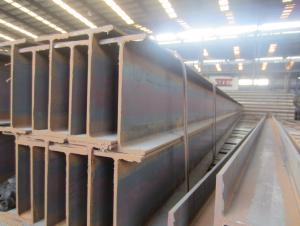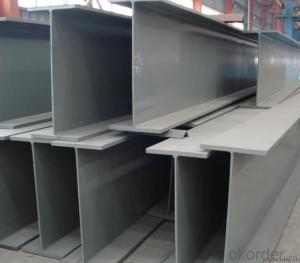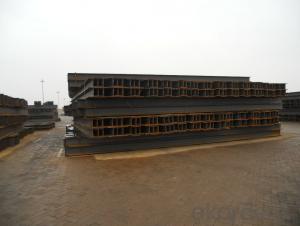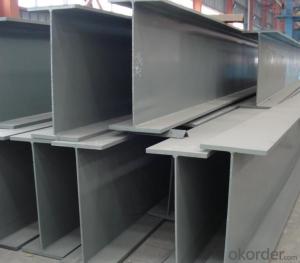I beam
- Loading Port:
- China Main Port
- Payment Terms:
- TT OR LC
- Min Order Qty:
- -
- Supply Capability:
- -
OKorder Service Pledge
OKorder Financial Service
You Might Also Like
Usage & Applications of Hot Rolled Steel H-beam For Sale
Commercial building structure ;Pre-engineered buildings; Machinery support structure; Prefabricated structure; Medium scale bridges; Ship-building structure.etc.
Packaging & Delivery of Hot Rolled Steel H-beam For Sale
1. Packing: it is nude packed in bundles by steel wire rod
2. Bundle weight: not more than 3.5MT for bulk vessel; less than 3 MT for container load
3. Marks:
Color marking: There will be color marking on both end of the bundle for the cargo delivered by bulk vessel. That makes it easily to distinguish at the destination port.
Tag mark: there will be tag mark tied up on the bundles. The information usually including supplier logo and name, product name, made in China, shipping marks and other information request by the customer.
If loading by container the marking is not needed, but we will prepare it as customer request.
4. Transportation: the goods are delivered by truck from mill to loading port, the maximum quantity can be loaded is around 40MTs by each truck. If the order quantity cannot reach the full truck loaded, the transportation cost per ton will be little higher than full load.
5. Delivered by container or bulk vessel
- Q:What are the requirements for steel H-beams in areas with heavy snowfall?
- In areas with heavy snowfall, the requirements for steel H-beams primarily focus on their structural integrity and load-bearing capacity to withstand the weight of accumulated snow. These requirements include: 1. Snow Load: The first consideration is the anticipated snow load in the specific area. The snow load is typically determined by local building codes or engineering standards and is expressed in pounds per square foot. The H-beams must be designed to support this snow load without excessive deflection or failure. 2. Material Strength: Steel H-beams used in heavy snowfall areas should have a high yield strength to withstand the increased load. The material used should have a minimum specified yield strength, such as ASTM A992 or equivalent, which ensures the beam's ability to resist bending and deformation under heavy snow loads. 3. Design Factors: The design of H-beams should consider additional factors such as safety margins, environmental conditions, and potential snow accumulation patterns. Structural engineers typically apply various design factors to account for uncertainties and ensure a reliable and durable structure. 4. Span Length and Section Dimensions: The span length of the H-beams, i.e., the distance between supports, should be determined considering the anticipated snow load. Longer spans may require larger section dimensions or additional support structures to prevent excessive deflection or failure. 5. Connections and Joints: The connections between H-beams and other structural elements should be appropriately designed and reinforced to withstand the snow load. Welding, bolting, or other connection methods must be chosen based on the specific requirements and engineering standards. 6. Maintenance and Inspection: Regular maintenance and inspection of steel H-beams are crucial in heavy snowfall areas. This includes removing any accumulated snow or ice, identifying any signs of corrosion or damage, and ensuring proper drainage to prevent ice dams or additional snow accumulation. It is important to consult with a qualified structural engineer or follow local building codes and regulations to determine the specific requirements for steel H-beams in areas with heavy snowfall. Additionally, local climate and snowfall patterns may vary, so a customized approach may be necessary to ensure the safety and reliability of the structure.
- Q:What are the different methods of connecting steel H-beams?
- Connecting steel H-beams in construction projects can be achieved through various methods, depending on specific requirements. Some commonly used methods include: 1. Welding: Popular for connecting steel H-beams, this method involves melting and fusing the beam edges using heat and pressure. Welded connections are strong and permanent, making them ideal for structural steel framing, bridges, and heavy-duty applications. 2. Bolting: Another common method is to secure the beams together using bolts and nuts. Bolted connections are easier to assemble and disassemble compared to welded connections, making them suitable for applications that may require future modifications or repairs. 3. Riveting: Although an older method, riveting is still used in certain applications. It involves using metal rivets to connect the steel H-beams. Riveted connections offer good strength and durability but require specialized equipment and skilled labor for installation. 4. Adhesive bonding: A modern method that utilizes structural adhesives to bond the steel H-beams, adhesive bonding is useful for achieving aesthetics and corrosion resistance. It eliminates the need for visible fasteners and provides some flexibility, allowing for joining of dissimilar materials. 5. Mechanical connectors: These pre-engineered devices offer a quick and efficient way to connect steel H-beams. They typically include plates, bolts, and other components designed for easy installation and high strength. Mechanical connectors are suitable for applications where speed and ease of assembly are crucial. The choice of connection method depends on factors such as load requirements, structural design, project specifications, and available skills and resources. It is recommended to consult a structural engineer or construction professional to determine the most suitable method for connecting steel H-beams in a specific project.
- Q:What are the factors to consider when selecting steel H-beams for a project?
- When selecting steel H-beams for a project, there are several important factors to consider. 1. Load-bearing capacity: The primary factor to consider is the load-bearing capacity of the H-beam. This includes both the dead load (the weight of the structure itself) and the live load (any additional weight that the structure may support). It is crucial to calculate the expected load and select a beam that can safely support it without deformation or failure. 2. Size and dimensions: The size and dimensions of the H-beam should be chosen based on the specific requirements of the project. The beam's height, width, and thickness will impact its load-carrying capacity and overall stability. It is essential to consult engineering and design guidelines to ensure the appropriate sizing for the project. 3. Material quality: The quality of the steel used in manufacturing the H-beams is crucial for the structural integrity and durability of the project. Factors such as the tensile strength, yield strength, and ductility of the steel should be considered. Higher grades of steel will generally have better strength properties, but they may come at a higher cost. 4. Corrosion resistance: Depending on the project's environmental conditions, it may be necessary to consider the corrosion resistance of the steel H-beams. If the structure will be exposed to moisture, chemicals, or other corrosive elements, selecting a beam with appropriate coatings or using stainless steel may be necessary to prevent deterioration and maintain the structural integrity over time. 5. Fabrication and installation requirements: The ease of fabrication and installation of the H-beams should also be taken into account. Consider factors such as the beam's shape, weight, and connection methods. Some projects may require pre-cut or pre-drilled beams for specific installation requirements, and these factors should be considered during the selection process. 6. Cost: Finally, the cost of the H-beams should be considered while balancing the project's budget with the desired quality and performance. Comparing prices from different suppliers and considering long-term costs, such as maintenance and replacement, can help make an informed decision. Overall, selecting steel H-beams for a project involves careful consideration of load-bearing capacity, size and dimensions, material quality, corrosion resistance, fabrication and installation requirements, and cost. Consulting with structural engineers and adhering to relevant building codes and standards is essential to ensure the safety and success of the project.
- Q:Can steel H-beams be used in museum or art gallery construction?
- Indeed, it is possible to utilize steel H-beams in the construction of museums or art galleries. These beams are frequently employed in construction endeavors owing to their robustness and endurance. By offering structural reinforcement and the ability to withstand substantial burdens, they prove ideal for accommodating vast and extensive areas such as those found in museums or art galleries. Furthermore, steel H-beams can be manufactured in different dimensions and forms to fulfill particular architectural designs and prerequisites. Their adaptability enables imaginative and adaptable construction solutions, thereby rendering them a favored option for museum and art gallery construction.
- Q:Are there any design guidelines or codes for using steel H-beams?
- Yes, there are design guidelines and codes for using steel H-beams. These guidelines and codes are provided by various organizations such as the American Institute of Steel Construction (AISC) in the United States or the Eurocodes in Europe. These guidelines cover various aspects including the design, fabrication, and erection of steel H-beams to ensure their structural integrity and safety in different applications.
- Q:Can steel H-beams be used for solar panel supports?
- Yes, steel H-beams can be used for solar panel supports. H-beams, also known as I-beams or universal beams, are commonly used in construction due to their strength and durability. They provide excellent structural support and can withstand the weight and wind loads associated with solar panel installations. Steel H-beams also have the advantage of being resistant to corrosion, making them suitable for outdoor applications such as solar panel supports. Additionally, their versatility allows for easy installation and adjustment to accommodate different solar panel sizes and angles. Therefore, steel H-beams are a reliable and widely used choice for supporting solar panels.
- Q:What are the different sizes of steel H-beams available?
- The sizes of steel H-beams available vary depending on the manufacturer and supplier. However, some common sizes include H-beams with depths ranging from 4 inches to over 40 inches, and flange widths ranging from 4 inches to over 20 inches. These sizes are often designated using standard measurements such as inches or millimeters.
- Q:What are the common fire protection measures for steel H-beams?
- Steel H-beams can be protected from fire through the use of various measures. One common method involves applying fire-resistant coatings directly onto the beams. These coatings are designed to endure high temperatures, effectively preventing the steel from reaching its critical temperature and thus maintaining its structural integrity. Another option is to use intumescent paints, which expand when exposed to heat. This expansion creates an insulating layer that slows down the transfer of heat to the steel beam, safeguarding it from the destructive effects of fire. Additionally, fire-resistant cladding can be installed around the steel H-beams. This cladding acts as an extra protective layer, insulating the steel from heat and flames. By implementing these measures, the structural stability of steel H-beams can be ensured during a fire, preventing any potential failure.
- Q:What are the common design considerations for steel H-beams in roofing applications?
- There are several common design considerations for steel H-beams in roofing applications. These considerations are important to ensure the structural integrity and safety of the roof. 1. Load-bearing capacity: Steel H-beams need to be designed to withstand the weight of the roof, as well as any additional loads such as snow, wind, or equipment. The beams should be properly sized and spaced to distribute the loads evenly and prevent any potential for failure or collapse. 2. Span and support spacing: The span and support spacing of the steel H-beams should be carefully determined based on the specific roof design and anticipated loads. The beams need to be adequately supported to prevent excessive deflection, sagging, or bending. The spacing between the beams should be determined in accordance with engineering standards and codes. 3. Connection details: The connections between the steel H-beams and other structural elements, such as columns or purlins, should be carefully designed and executed. The connections need to be strong and secure to ensure proper load transfer and to prevent any potential for disconnection or failure. 4. Fire resistance: Steel H-beams used in roofing applications should be designed to provide adequate fire resistance. This can be achieved through the use of fire-resistant coatings, insulation materials, or by incorporating fire-rated materials into the design. 5. Corrosion protection: Steel H-beams are susceptible to corrosion, especially in outdoor roofing applications where they are exposed to the elements. Proper corrosion protection measures, such as galvanizing or using corrosion-resistant coatings, should be implemented to extend the lifespan of the beams and maintain their structural integrity. 6. Thermal expansion and contraction: Steel H-beams need to be designed to accommodate thermal expansion and contraction due to temperature variations. This can be achieved by incorporating expansion joints or allowing for appropriate clearance and movement in the design. 7. Sustainability considerations: In modern design, sustainability is a key consideration. The use of recycled steel or incorporating energy-efficient design elements can contribute to the overall sustainability of the roofing system. Overall, the design of steel H-beams in roofing applications should take into account load-bearing capacity, span and support spacing, connection details, fire resistance, corrosion protection, thermal expansion and contraction, and sustainability considerations. By addressing these design considerations, the steel H-beams can provide a safe and durable roofing solution.
- Q:Can steel H-beams be used in automotive manufacturing?
- Certainly! Steel H-beams have a multitude of applications in automotive manufacturing. These beams, also referred to as I-beams or universal beams, are renowned in the construction industry for their durability and strength. However, they are equally valuable in the automotive sector. H-beams can be effectively incorporated into vehicle frames, chassis, and suspension systems. Their exceptional structural support allows them to bear heavy loads and endure impacts, thus guaranteeing the safety and stability of the vehicle. Moreover, H-beams are perfect for the production of engine components, including connecting rods and crankshafts, owing to their high tensile strength and resistance against bending and twisting forces. Furthermore, steel H-beams offer additional benefits such as cost-effectiveness, easy availability, and simple fabrication. They can be easily obtained from steel suppliers and are accessible in a wide assortment of sizes and specifications, making them well-suited for various automotive applications. Additionally, steel is a recyclable material, aligning with the growing emphasis on sustainability and environmental consciousness within the automotive industry. In conclusion, steel H-beams are undeniably valuable in automotive manufacturing due to their strength, durability, versatility, and cost-effectiveness. Their utilization in vehicle frames, suspension systems, and engine components enhances the overall safety, stability, and performance of automobiles.
1. Manufacturer Overview |
|
|---|---|
| Location | |
| Year Established | |
| Annual Output Value | |
| Main Markets | |
| Company Certifications | |
2. Manufacturer Certificates |
|
|---|---|
| a) Certification Name | |
| Range | |
| Reference | |
| Validity Period | |
3. Manufacturer Capability |
|
|---|---|
| a)Trade Capacity | |
| Nearest Port | |
| Export Percentage | |
| No.of Employees in Trade Department | |
| Language Spoken: | |
| b)Factory Information | |
| Factory Size: | |
| No. of Production Lines | |
| Contract Manufacturing | |
| Product Price Range | |
Send your message to us
I beam
- Loading Port:
- China Main Port
- Payment Terms:
- TT OR LC
- Min Order Qty:
- -
- Supply Capability:
- -
OKorder Service Pledge
OKorder Financial Service
Similar products
New products
Hot products
Hot Searches
Related keywords






























